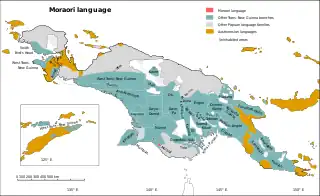Morori language
Morori (Marori, Moaraeri, Moraori, Morari) is a moribund Papuan language of the Kolopom branch of the Trans–New Guinea family. It is separated from the other Kolopom languages by the intrusive Marind family.[3] All speakers use Papuan Malay or Indonesian as L2, and many know Marind.[2]
| Morori | |
|---|---|
| Marori | |
| Moraori | |
| Region | Kampung Wasur, Merauke Regency, South Papua, Indonesia[1] |
| Ethnicity | Marori; 250 (1998)[2] |
Native speakers | (50 cited 1998)[2] |
Trans–New Guinea
| |
| Language codes | |
| ISO 639-3 | mok |
| Glottolog | moro1289 |
| ELP | Marori |
 Map: The Morori language of New Guinea
The Morori language (near the southern cape)
Other Trans–New Guinea languages
Other Papuan languages
Austronesian languages
Uninhabited | |
A dialect extinct in 1997, Menge, is remembered from ceremonial use.
Marori is spoken in Kampung Wasur, which in 2010 had 413 people (98 families) total and 119 Marori people (52 Marori families).[1]
Phonology
Marori has 22 consonants and 6 vowels, which are:[1]
| Labial | Alveolar | Palatal | Velar | Glottal | ||
|---|---|---|---|---|---|---|
| Nasal | m | n | ɲ | ŋ | ||
| Plosive | prenasal | ᵐb | ⁿd | ⁿʤ | ᵑɡ | |
| voiced | b | d | ɡ | |||
| voiceless | p | t | k | |||
| Fricative | ɸ | s | h | |||
| Approximant | w | l | j | |||
| Rhotic | r | |||||
- Vowels
- i, e, æ, a, o, u
On the other hand, the majority of Trans-New Guinea languages usually have around 10–15 consonants.[1]
Pronouns
Pronouns, but little else, connect it to TNG:
sg pl 1 na ni-ɛ 2 ka ki-ɛ 3 ŋɡafi ŋɡamdɛ
Vocabulary
The following basic vocabulary words are from Voorhoeve (1975),[4] as cited in the Trans-New Guinea database:[5]
gloss Morori head merao hair pu eye ayix tooth terox leg tegu louse nemeŋk dog koro pig bosik bird ujif egg vi blood ŋgorom bone ŋgwar skin par tree kwi man yexri sun kum water deke fire sir stone mere name nex eat kef one sekodu two yenadu
Evolution
Marori reflexes of proto-Trans-New Guinea (pTNG) etyma are:[6]
- mam ‘breast’ < *amu
- mam ‘mother’ < *am(a,i)
- nemeŋk ‘louse’ < *niman
- sa ‘sand’ < *sa(ŋg,k)asiŋ
- ŋwar ‘bone’ < *kondaC
Further reading
- Gebze, Wilhelmus and Mark Donohue. 1998. Kamus Kecil Bahasa Moraori. [Marori picture dictionary]: Distributed in Wasur, Papua.
References
- Evans, Nicholas (2018). "The languages of Southern New Guinea". In Palmer, Bill (ed.). The Languages and Linguistics of the New Guinea Area: A Comprehensive Guide. The World of Linguistics. Vol. 4. Berlin: De Gruyter Mouton. pp. 641–774. ISBN 978-3-11-028642-7.
- Morori at Ethnologue (18th ed., 2015) (subscription required)
- New Guinea World, Kolopom
- Voorhoeve, C.L. Languages of Irian Jaya: Checklist. Preliminary classification, language maps, wordlists. B-31, iv + 133 pages. Pacific Linguistics, The Australian National University, 1975. doi:10.15144/PL-B31
- Greenhill, Simon (2016). "TransNewGuinea.org - database of the languages of New Guinea". Retrieved 2020-11-05.
- Pawley, Andrew; Hammarström, Harald (2018). "The Trans New Guinea family". In Palmer, Bill (ed.). The Languages and Linguistics of the New Guinea Area: A Comprehensive Guide. The World of Linguistics. Vol. 4. Berlin: De Gruyter Mouton. pp. 21–196. ISBN 978-3-11-028642-7.
- Ross, Malcolm (2005). "Pronouns as a preliminary diagnostic for grouping Papuan languages". In Andrew Pawley; Robert Attenborough; Robin Hide; Jack Golson (eds.). Papuan pasts: cultural, linguistic and biological histories of Papuan-speaking peoples. Canberra: Pacific Linguistics. pp. 15–66. ISBN 0858835622. OCLC 67292782.
- Arka, I Wayan. 2012. Projecting morphology and agreement in Marori, an isolate of southern New Guinea. In Nicholas Evans and Marian Klamer (eds.), Melanesian Languages on the Edge of Asia: Challenges for the 21st Century, 150-173. Honolulu: University of Hawaii Press.
External links
- ELAR Collection: The Endangered Papuan Languages of Merauke-Indonesia: ethnobiological and linguistic documentation deposited by I Wayan Arka